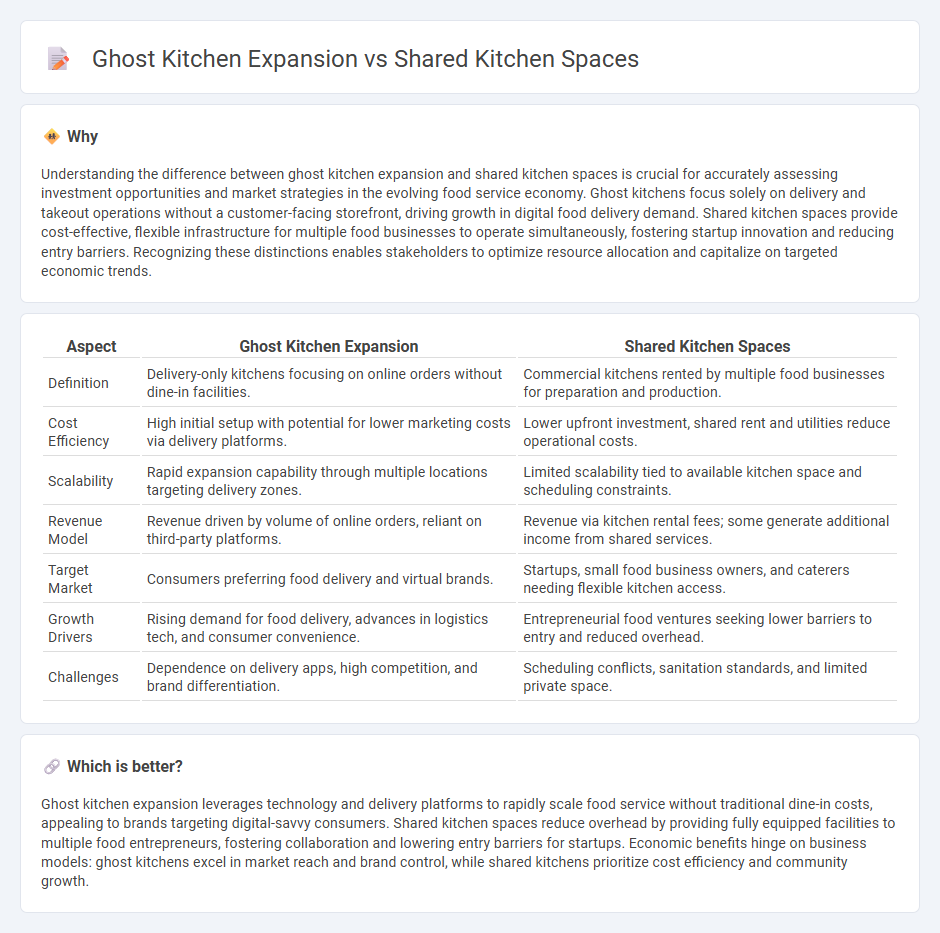
Ghost kitchen expansion drives rapid growth in virtual dining, leveraging technology to optimize delivery-only food services and reduce operational costs. Shared kitchen spaces provide flexible, cost-effective solutions for emerging food entrepreneurs seeking to minimize overhead while scaling production. Explore the evolving dynamics between ghost kitchens and shared spaces to understand their impact on the future of the foodservice economy.
Why it is important
Understanding the difference between ghost kitchen expansion and shared kitchen spaces is crucial for accurately assessing investment opportunities and market strategies in the evolving food service economy. Ghost kitchens focus solely on delivery and takeout operations without a customer-facing storefront, driving growth in digital food delivery demand. Shared kitchen spaces provide cost-effective, flexible infrastructure for multiple food businesses to operate simultaneously, fostering startup innovation and reducing entry barriers. Recognizing these distinctions enables stakeholders to optimize resource allocation and capitalize on targeted economic trends.
Comparison Table
| Aspect | Ghost Kitchen Expansion | Shared Kitchen Spaces |
|---|---|---|
| Definition | Delivery-only kitchens focusing on online orders without dine-in facilities. | Commercial kitchens rented by multiple food businesses for preparation and production. |
| Cost Efficiency | High initial setup with potential for lower marketing costs via delivery platforms. | Lower upfront investment, shared rent and utilities reduce operational costs. |
| Scalability | Rapid expansion capability through multiple locations targeting delivery zones. | Limited scalability tied to available kitchen space and scheduling constraints. |
| Revenue Model | Revenue driven by volume of online orders, reliant on third-party platforms. | Revenue via kitchen rental fees; some generate additional income from shared services. |
| Target Market | Consumers preferring food delivery and virtual brands. | Startups, small food business owners, and caterers needing flexible kitchen access. |
| Growth Drivers | Rising demand for food delivery, advances in logistics tech, and consumer convenience. | Entrepreneurial food ventures seeking lower barriers to entry and reduced overhead. |
| Challenges | Dependence on delivery apps, high competition, and brand differentiation. | Scheduling conflicts, sanitation standards, and limited private space. |
Which is better?
Ghost kitchen expansion leverages technology and delivery platforms to rapidly scale food service without traditional dine-in costs, appealing to brands targeting digital-savvy consumers. Shared kitchen spaces reduce overhead by providing fully equipped facilities to multiple food entrepreneurs, fostering collaboration and lowering entry barriers for startups. Economic benefits hinge on business models: ghost kitchens excel in market reach and brand control, while shared kitchens prioritize cost efficiency and community growth.
Connection
Ghost kitchen expansion thrives on the increased utilization of shared kitchen spaces, which reduce overhead costs and enable multiple food brands to operate efficiently under one roof. Shared kitchen facilities provide scalable infrastructure and flexible lease options, allowing ghost kitchens to rapidly test new market segments and menu concepts without traditional restaurant expenses. This synergy accelerates the growth of delivery-only food services and transforms urban food economies by maximizing kitchen space productivity.
Key Terms
Asset Utilization
Shared kitchen spaces maximize asset utilization by enabling multiple food businesses to operate within a single physical location, reducing downtime and overhead costs. Ghost kitchen expansion drives asset efficiency through centralized production focused solely on delivery, optimizing kitchen throughput and minimizing unused capacity. Explore how these models transform foodservice operations and optimize asset utilization in depth.
Scalability
Shared kitchen spaces offer flexibility and lower upfront costs, enabling scalable operations for food entrepreneurs by providing access to fully equipped facilities without long-term leases. Ghost kitchens prioritize rapid scalability with streamlined delivery-focused models, leveraging technology and data analytics to optimize menu offerings and expand delivery zones efficiently. Explore the dynamic growth strategies behind shared and ghost kitchen scalability to maximize your food business potential.
Operational Efficiency
Shared kitchen spaces enable multiple food businesses to reduce overhead costs by sharing equipment, utilities, and staff, leading to improved operational efficiency. Ghost kitchen expansion focuses on streamlining delivery-only food production, leveraging technology to optimize order management and reduce turnaround times. Explore how both models can maximize profitability and scalability in the evolving foodservice industry.
Source and External Links
Coworking Space and Shared Kitchen in Pittsburgh - Offers commercial shared kitchen memberships starting at $900/month providing licensed prep space, storage, commercial equipment, and supportive services tailored for food entrepreneurs and food trucks.
Shared Kitchens | City of New York - NYC.gov: Business - Shared kitchens are licensed commercial food facilities that let food entrepreneurs rent kitchen space to grow without owning a kitchen, regulated by NYC Health Department permits and certifications.
Shared-use Kitchens: The Definitive Guide - Optix - Defines shared commercial kitchens as affordable, licensed professional-grade cooking spaces that lower barriers for food entrepreneurs and foster collaboration, flexible scheduling, and business growth.
 dowidth.com
dowidth.com